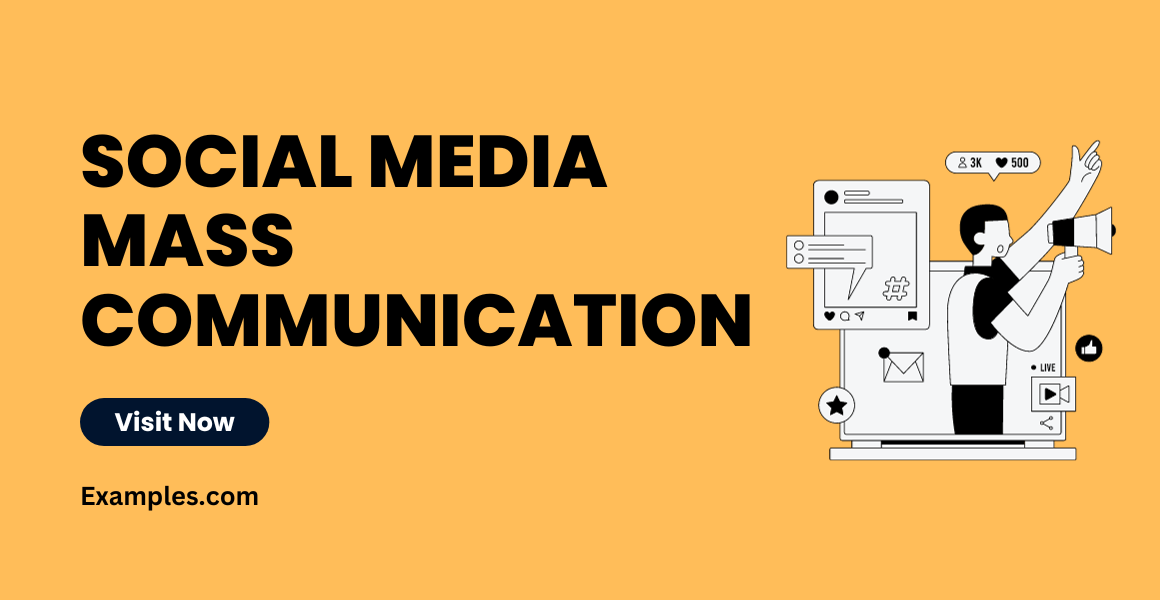49+ Social Media Mass Communication Examples
Social Media Mass Communication stands at the forefront of modern digital interaction, revolutionizing how information is shared and consumed. This comprehensive guide delves into the dynamic world of social media as a mass communication tool, exploring its powerful influence and diverse applications. From viral marketing campaigns to grassroots social movements, this guide includes practical communication examples, showcasing how social media platforms like Twitter, Facebook, and Instagram have become pivotal in shaping public discourse, brand identity, and global connectivity.
What is Social Media in Mass Communication?
Social media in mass communication refers to the use of internet-based platforms like Facebook, Twitter, and Instagram to disseminate information to a large audience rapidly. It’s a powerful tool that allows individuals and organizations to share content, from text and images to videos and podcasts, with a global audience. In mass communication, social media is recognized for its real-time interaction, wide reach, and the ability to facilitate direct engagement and feedback from the audience, making it a key player in today’s digital media landscape.
50 Social Media Mass Communication Examples
Social media has become an indispensable part of mass communication, offering diverse ways to share information, engage with audiences, and influence public opinion. This collection presents 50 unique and impactful examples of social media usage in mass communication. Ranging from viral marketing campaigns to social advocacy, these examples illustrate the power of social media platforms in shaping narratives, fostering community engagement, and driving social change. They highlight the versatility of social media in reaching diverse audiences, promoting interactive communication, and its growing significance in the digital era.
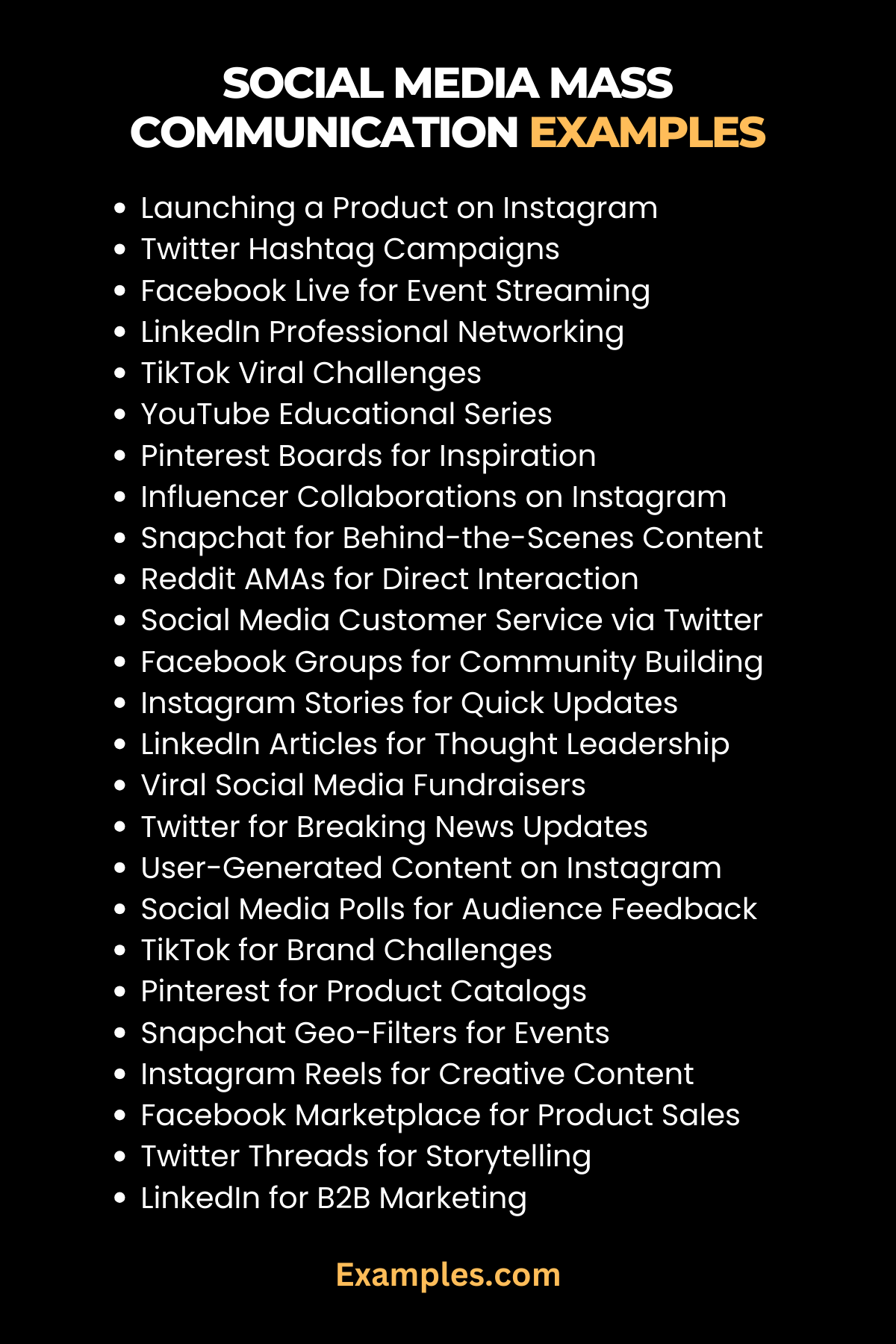
- Launching a Product on Instagram: “Excited to introduce our eco-friendly skincare line! ” Launching products on Instagram can visually captivate and directly engage a consumer base.
- Twitter Hashtag Campaigns: “#SaveTheBees campaign to raise awareness about bee conservation.” Hashtags on Twitter can create viral movements and bring attention to causes.
- Facebook Live for Event Streaming: “Join us live for the grand opening of our new store!” Facebook Live offers real-time audience engagement and wide event coverage.
- LinkedIn Professional Networking: “Connecting industry experts to discuss the future of tech.” LinkedIn is ideal for professional networking and industry-specific discussions.
- TikTok Viral Challenges: “Take on our #HealthyEatingChallenge and share your journey.” TikTok challenges can rapidly spread, promoting brands or causes engagingly.
- YouTube Educational Series: “Our weekly YouTube series breaks down complex science topics.” Educational content on YouTube can reach a wide audience with informative videos.
- Pinterest Boards for Inspiration: “Check out our Pinterest for home decor ideas.” Pinterest is perfect for sharing thematic content and inspiring visuals.
- Influencer Collaborations on Instagram: “Teaming up with @eco_influencer to showcase our sustainable fashion line.” Influencers can significantly amplify a brand’s message and reach.

- Snapchat for Behind-the-Scenes Content: “Snapchat takeover by our team at the fashion week!” Snapchat offers a unique platform for sharing spontaneous, behind-the-scenes content.
- Reddit AMAs for Direct Interaction: “Join our CEO for a Reddit AMA about renewable energy.” Reddit AMAs are a great way to engage with a curious and engaged audience.
- Social Media Customer Service via Twitter: “Experiencing issues? Tweet us for instant support.” Twitter is widely used for prompt customer service and interaction.
- Facebook Groups for Community Building: “Join our Facebook group for parenting tips and support.” Facebook groups foster community engagement around specific interests or causes.
- Instagram Stories for Quick Updates: “Check our story for daily health tips!” Instagram Stories offer a platform for sharing brief, engaging updates.
- LinkedIn Articles for Thought Leadership: “Our latest article on LinkedIn discusses market trends post-COVID.” Publishing articles on LinkedIn can establish thought leadership in a field.
- Viral Social Media Fundraisers: “Help us reach our goal to build community gardens! #GreenCityFundraiser” Fundraisers on social media can quickly gain traction and support.
- Twitter for Breaking News Updates: “Follow our live tweet coverage of the election results.” Twitter is a go-to platform for immediate news updates and discussions.
- User-Generated Content on Instagram: “Share your experience with our product using #MyJourneyWithXYZ.” Encouraging user-generated content increases authenticity and brand engagement.
- Social Media Polls for Audience Feedback: “Vote on our next product launch in our Facebook poll!” Polls are a simple way to engage audiences and gather feedback.
- TikTok for Brand Challenges: “Join our #FitnessFun challenge and show your workout routines.” Brand challenges on TikTok can increase visibility and user engagement.
- Pinterest for Product Catalogs: “Our full range of handcrafted jewelry is now on Pinterest.” Pinterest allows businesses to showcase their products aesthetically.
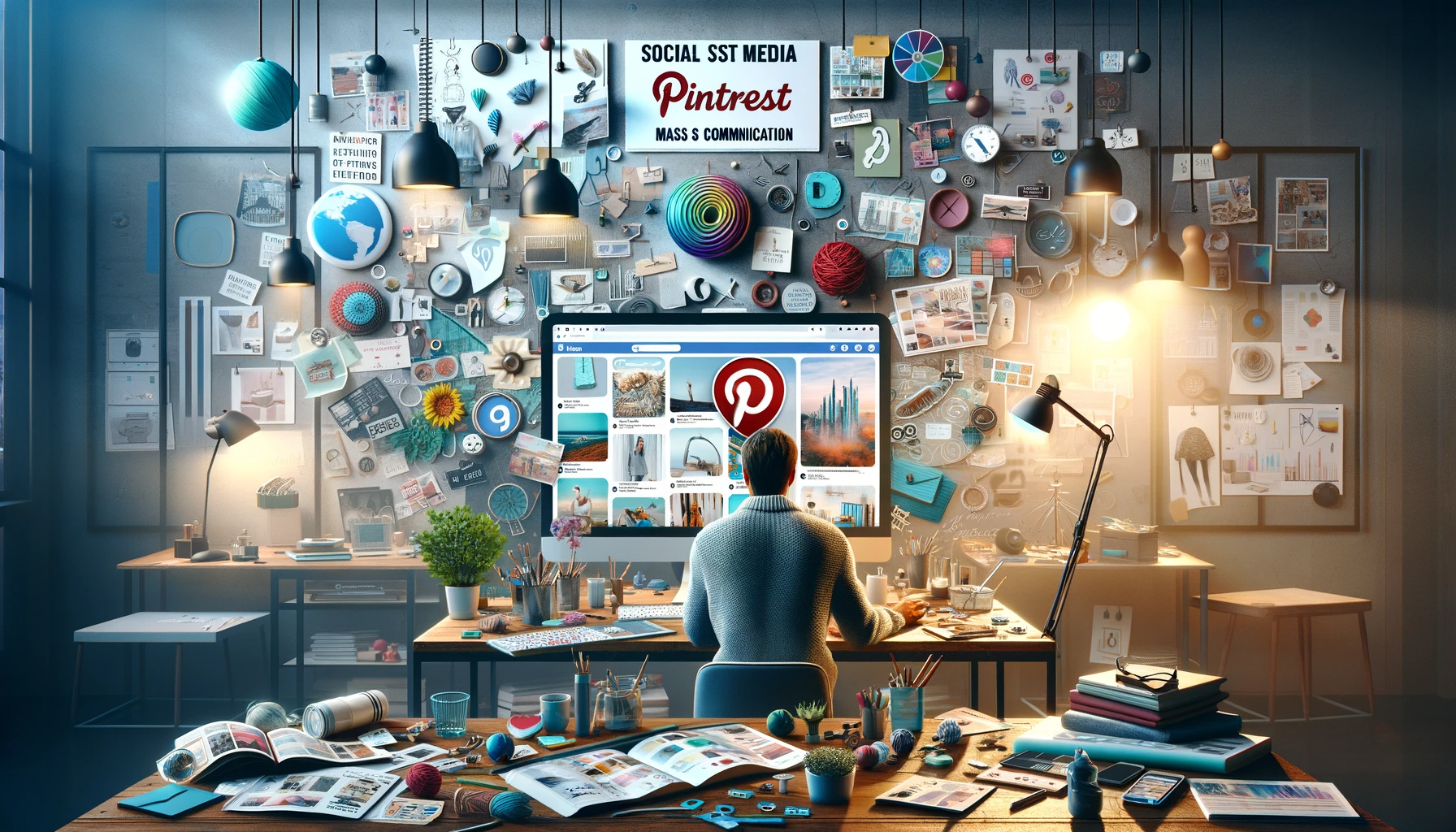
- Snapchat Geo-Filters for Events: “Use our special filter at the music festival this weekend!” Geo-filters enhance event experiences and promote location-based engagement.
- Instagram Reels for Creative Content: “Watch our latest reel for easy vegan recipes!” Instagram Reels offers a platform for creative, short-form video content.
- Facebook Marketplace for Product Sales: “Visit our Facebook Marketplace for exclusive deals on vintage clothes.” The Marketplace enables businesses to sell products directly within Facebook.
- Twitter Threads for Storytelling: “Follow our thread for an inspiring story of our non-profit’s journey.” Twitter threads are effective for sharing longer narratives in segments.
- LinkedIn for B2B Marketing: “Connect with us on LinkedIn for industry insights and B2B solutions.” LinkedIn is key for B2B marketing and professional connections.
- YouTube for Product Reviews and Demos: “Check out our YouTube channel for detailed reviews of our latest gadgets.” YouTube is ideal for in-depth product demonstrations and reviews.
- Instagram Live Q&A Sessions: “Join our live Q&A to discuss mental health awareness.” Instagram Live sessions offer real-time interaction with audiences.
- Facebook Events for Organizing Gatherings: “Mark your calendar! Join our Facebook event for the community clean-up day.” Facebook Events is a useful tool for organizing and promoting events.
- TikTok for Educational Content: “Learn a new science fact every day with our TikTok series.” TikTok’s short video format is great for educational snippets.
- Social Media Advocacy Campaigns: “Support our #EducationForAll campaign to promote literacy.” Advocacy campaigns on social media can mobilize support for social causes.
- Pinterest for DIY and How-to Guides: “Find step-by-step guides for DIY home projects on our Pinterest.” Pinterest is a hub for DIY enthusiasts and how-to content.
- Snapchat Stories for Daily Engagement: “Follow our daily Snapchat stories to see life at our company.” Snapchat stories provide a casual platform for daily updates.
- Instagram Hashtag Campaigns for Brand Awareness: “Use #BeBoldWithXYZ to be featured on our page!” Hashtag campaigns on Instagram can enhance brand visibility and engagement.
- Twitter for Live Event Coverage: “We’re live-tweeting from the tech conference! #TechCon2023” Live-tweeting events can engage audiences who can’t attend in person.
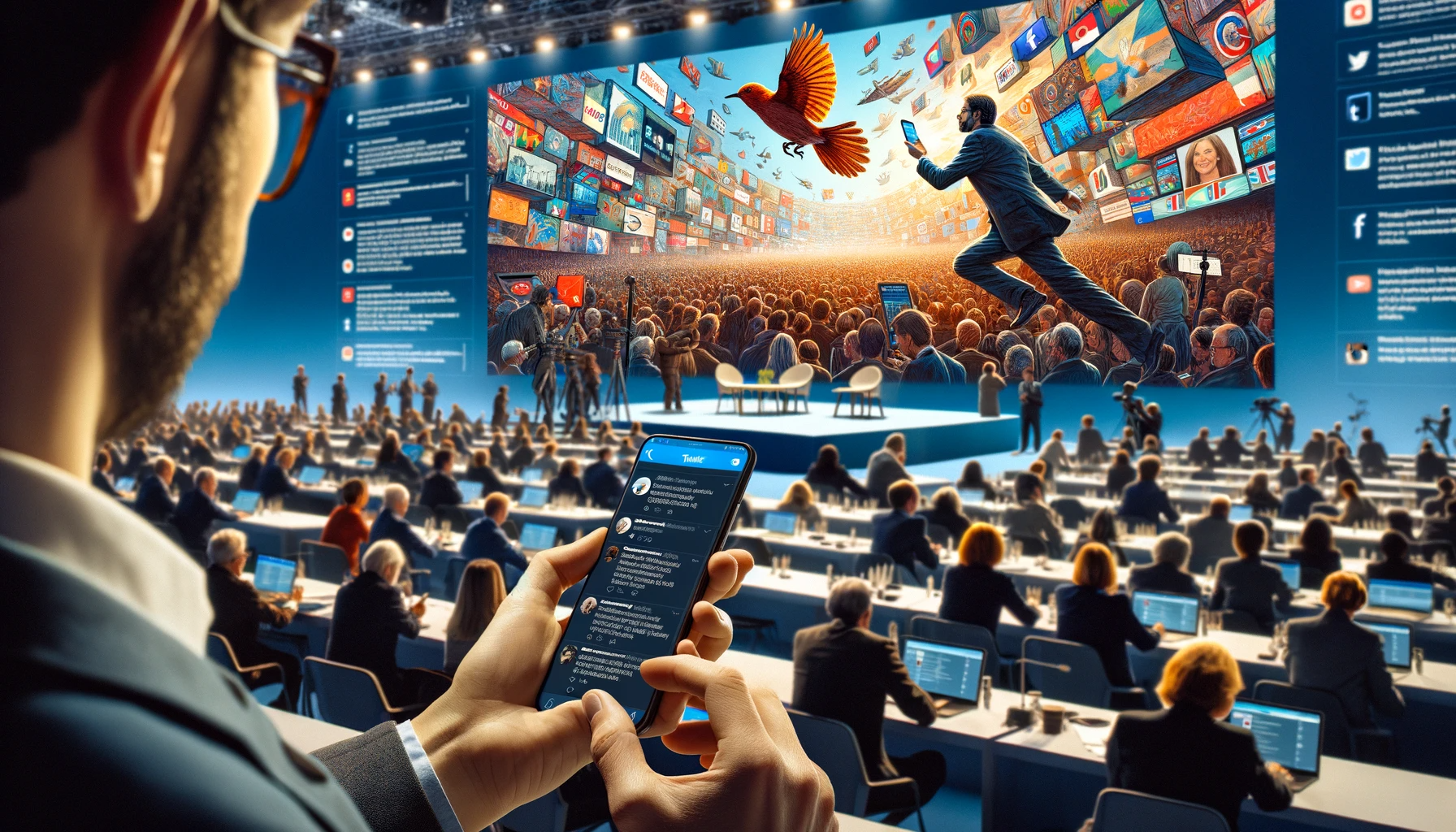
- User-Generated Video Contests on TikTok: “Enter our TikTok video contest and win exciting prizes!” Video contests encourage creative audience participation and content creation.
- Facebook for Brand Storytelling: “Our journey from a small startup to a leading tech company.” Facebook is effective for sharing brand stories and milestones.
- Instagram for Visual Branding: “Our Instagram feed reflects our brand’s aesthetic and values.” Instagram’s visual nature is key for cohesive visual branding.
- LinkedIn for Corporate Announcements: “We’re excited to announce our latest partnership on LinkedIn.” LinkedIn is a professional platform for corporate news and updates.
- YouTube for Behind-the-Scenes Content: “Go behind the scenes of our latest project on YouTube.” YouTube allows for longer-form content showcasing behind-the-scenes insights.
- Instagram and Facebook Shops for E-commerce: “Browse our latest collection in our Instagram and Facebook shops.” Social media shops integrate e-commerce directly into social platforms.
- Twitter Polls for Quick Audience Insights: “What feature do you want to see next? Vote in our poll!” Twitter polls offer a quick way to gauge audience preferences.
- Pinterest Mood Boards for Brand Inspiration: “Explore our mood boards on Pinterest for design inspiration.” Mood boards on Pinterest can visually convey a brand’s essence.
- Snapchat for Exclusive Offers and Promotions: “Check our Snapchat for exclusive flash deals!” Snapchat can be used for time-sensitive offers and promotions.
- Instagram Carousels for Storytelling: “Swipe through our carousel to see the story of our latest campaign.” Instagram carousels allow for multi-image posts ideal for storytelling.
- Facebook for Customer Testimonials and Reviews: “Hear what our customers are saying on our Facebook reviews.” Customer testimonials on Facebook build trust and credibility.

- TikTok for Showcase of Services: “Watch how we transform spaces in our TikTok videos!” TikTok can visually showcase services in an engaging format.
- Twitter for Industry Insights and Trends: “Follow us for the latest updates and trends in digital marketing.” Twitter is great for sharing industry news and insights.
- YouTube for Q&A and FAQ Sessions: “Our latest YouTube video answers your frequently asked questions.” YouTube Q&A sessions provide valuable information to the audience.
- LinkedIn for Employee Spotlights and Achievements: “Celebrating our team’s achievements on LinkedIn.” LinkedIn is ideal for highlighting employee stories and professional milestones.
- Facebook and Instagram Stories for Daily Updates: “Stay updated with our daily activities on Facebook and Instagram Stories.” Stories offer a casual and engaging way to connect daily.
Why is Social Media Used for Mass Communication?
Social media has become a cornerstone in the field of mass communication due to its unparalleled reach and interactive nature. It is increasingly used as a primary tool for disseminating information, engaging with audiences, and shaping public opinion. Here’s a detailed look at why social media is so integral to mass communication in today’s digital era.
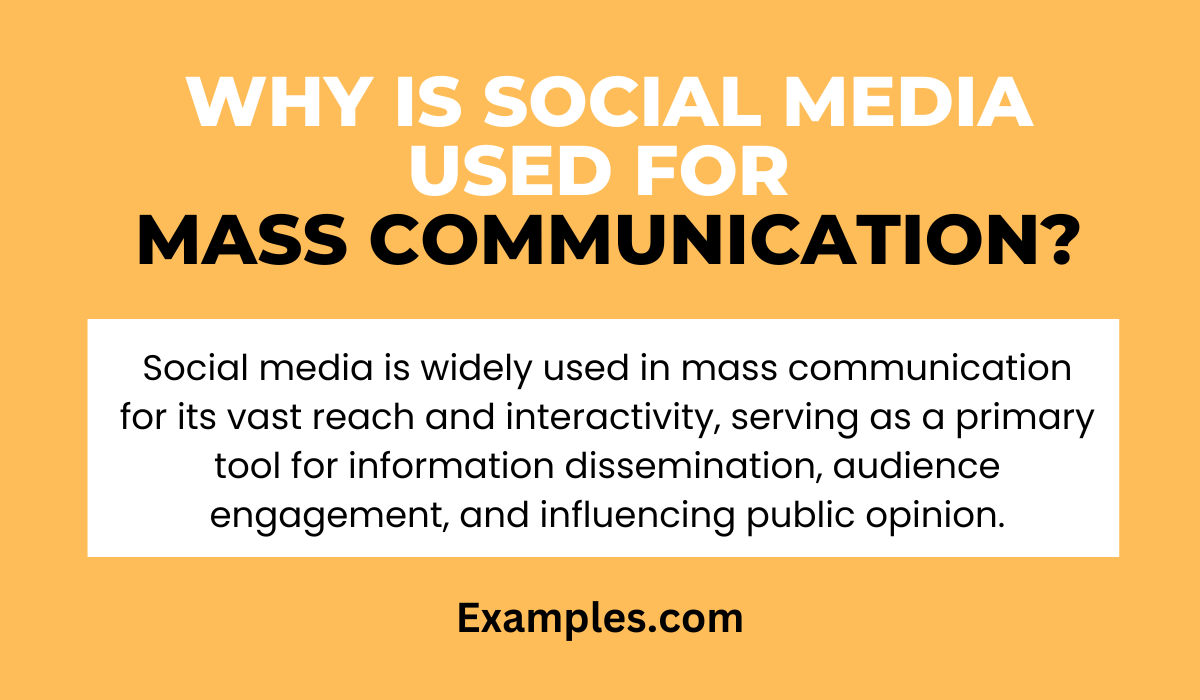
Wide and Diverse Audience Reach
- Global Accessibility: Social media platforms like Facebook and Twitter offer global accessibility, allowing messages to reach a worldwide audience rapidly.
- Diverse Demographics: These platforms cater to a wide range of demographics, making them suitable for targeting diverse audience segments.
Cost-Effective Communication
- Low Cost: Social media provides a cost-effective alternative to traditional media, making it accessible for all sizes of organizations and individuals.
- High ROI: The return on investment for social media campaigns can be significant due to their wide reach and low operational costs.
Real-Time Interaction and Engagement
- Instant Feedback: Platforms like Instagram and TikTok allow for real-time feedback and interaction with the audience, enhancing audience engagement and relationship building.
- Engagement Metrics: Social media offers valuable data through likes, shares, comments, and views, which are critical in measuring engagement and tailoring future content.
Customization and Personalization
- Targeted Content: Social media enables the creation of tailored content that resonates with specific audience groups, increasing its relevance and impact.
- Personalization Algorithms: These platforms use sophisticated algorithms to present users with content that matches their interests and behaviors, enhancing user experience and engagement.
Versatility in Content Presentation
- Multimedia Formats: Social media supports various content formats, including text, images, videos, and live streams, offering creative flexibility.
- Storytelling Potential: The multimedia nature of social media aids in effective storytelling, which is crucial for engaging and persuasive communication.
Brand Building and Promotion
- Brand Visibility: Social media is an effective tool for building brand visibility and recognition.
- Promotional Opportunities: It offers numerous opportunities for promoting products, services, and causes to a broad audience.
Accessibility and Convenience
- Easy Access: The widespread availability of smartphones and internet connectivity makes social media easily accessible to a large segment of the population.
- User-Friendly Interfaces: Social media platforms are designed for ease of use, encouraging more people to engage with the content.
Viral Potential
- Shareability: Content on social media can quickly go viral, reaching millions of people in a short span.
- Network Effects: The interconnected nature of social media networks facilitates the rapid spread of information.
What is the Impact of Social Media on Mass Communication?
Social media’s advent has profoundly transformed the landscape of mass communication. Its influence extends across various domains, reshaping how information is disseminated and consumed.
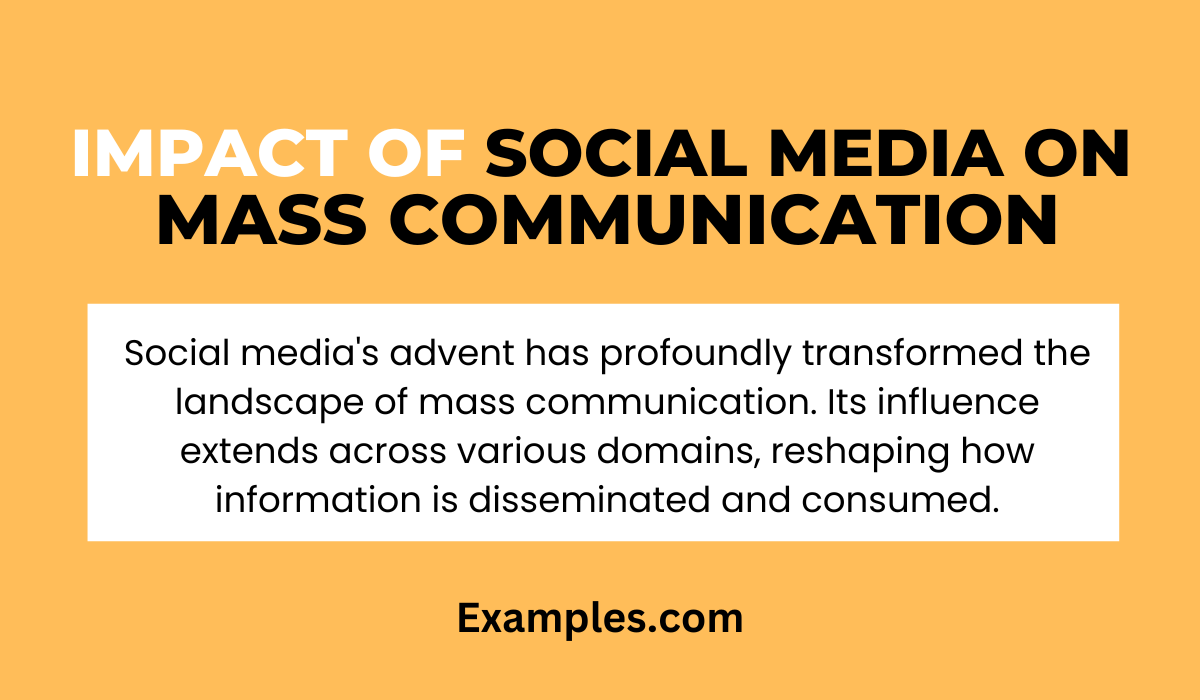
Here’s an exploration of the significant impacts social media has had on mass communication.
Enhanced Speed and Reach of Information
- Immediate Dissemination: Social media allows for the instantaneous sharing of news and information, significantly speeding up the dissemination process.
- Global Reach: Platforms like Twitter and Facebook enable messages to reach a global audience, breaking geographical barriers that traditional media often faces.
Shift in Traditional Media Roles
- Decentralization of Information Sources: Social media has challenged traditional gatekeeping roles in journalism, allowing anyone to publish and distribute content.
- Collaborative Journalism: There’s a growing trend of collaborative reporting, with traditional media often sourcing and verifying information from social media.
Increased Audience Engagement and Participation
- Interactive Communication: Social media fosters two-way communication, allowing audiences to engage, comment, and interact directly with content creators.
- User-Generated Content: Platforms enable users to create and share their content, leading to a more participatory culture in media.
Personalization of Content
- Tailored User Experiences: Social media algorithms personalize content feeds, showing users information that aligns with their interests and past interactions.
- Niche Marketing and Micro-targeting: For marketers, social media offers tools for highly targeted advertising, reaching specific audience segments based on detailed demographics and interests.
Impact on Public Opinion and Social Change
- Opinion Formation: Social media significantly influences public opinion, with trending topics and viral content shaping societal views and discussions.
- Mobilization for Social Causes: It has become a critical platform for mobilizing social and political movements, from local community issues to global causes.
Challenges in Information Quality and Reliability
- Spread of Misinformation: The ease of sharing on social media can lead to the rapid spread of fake news and misinformation.
- Need for Media Literacy: This environment necessitates a greater emphasis on media literacy to enable users to discern credible information sources.
Changes in Advertising and Marketing Strategies
- Influencer Marketing: The rise of social media influencers has introduced a new dynamic in advertising, where brands leverage these individuals’ reach and credibility.
- Content Marketing: Businesses increasingly rely on content marketing strategies, using engaging and valuable content to attract and retain customers.
Transformation in Public Relations
- Direct Brand-Customer Interaction: Social media allows for direct interaction between brands and their audience, offering a platform for customer service and community building.
- Real-Time Crisis Management: Companies use social media for real-time crisis communication and reputation management.
What are the Benefits of Social Media in Mass Communication?
Social media has significantly impacted the field of mass communication, bringing forth numerous benefits that have transformed how information is shared and received. Its influence extends beyond traditional boundaries, offering advantages that cater to the dynamic needs of today’s digital society. Here’s an in-depth look at the key benefits social media offers in the realm of mass communication.

Wider Audience Reach
- Global Connectivity: Social media platforms like Facebook and Instagram connect users across the globe, transcending geographical barriers and enabling messages to reach international audiences.
- Diverse Audience Engagement: These platforms cater to a variety of demographics, interests, and cultures, making them ideal for reaching a diverse audience base.
Cost-Effective Communication
- Affordability: Social media provides a low-cost alternative for communication, especially for small businesses or individuals with limited budgets.
- High Return on Investment: The potential for wide reach and targeted advertising on social media platforms often results in a high return on investment for marketing campaigns.
Real-Time Interaction and Feedback
- Instant Communication: Platforms like Twitter allow for real-time updates and interactions, providing immediate communication channels.
- Valuable Feedback: Direct engagement with audiences on social media offers instant feedback, insights, and audience sentiments.
Personalization and Targeting
- Customized Content: Social media algorithms enable the delivery of personalized content to users, increasing relevance and engagement.
- Targeted Advertising: Platforms offer sophisticated targeting options, allowing for micro-targeted advertising campaigns based on user behavior, interests, and demographics.
Enhanced Brand Visibility and Awareness
- Brand Exposure: Consistent and strategic social media use increases brand visibility and awareness.
- Viral Marketing Potential: The shareable nature of social media content can lead to viral campaigns, significantly boosting brand exposure.
Improved Customer Relations and Loyalty
- Direct Customer Engagement: Social media facilitates direct interaction with customers, enhancing customer service and building stronger relationships.
- Community Building: Brands can use social media to create and nurture online communities, fostering customer loyalty and advocacy.
Crisis Management and Reputation Control
- Rapid Response: Social media enables organizations to respond quickly to crises or negative feedback, helping to manage and control their reputation.
- Proactive Communication: Companies can use social media to issue statements, clarify information, and maintain public confidence during crises.
Access to Valuable Insights and Data
- Audience Analytics: Social media platforms provide valuable data on audience demographics, behavior, and preferences, aiding in market research and strategy development.
- Content Performance Tracking: Tools for monitoring engagement, reach, and interaction help in analyzing content performance and shaping future strategies.
Encouraging Participation and Activism
- Social and Political Mobilization: Social media platforms are instrumental in mobilizing social and political movements, allowing individuals to participate in activism and public discourse.
- Public Opinion Shaping: The platforms play a significant role in shaping public opinion on various topics, influencing societal trends and decisions.
The benefits of social media in mass communication are vast and varied, encompassing enhanced audience reach, cost-effectiveness, personalization, and real-time engagement.
How to Use Social Media Mass Communication
Incorporating social media into mass communication strategies requires a nuanced approach that takes advantage of the unique features of these platforms. Whether it’s for brand promotion, information dissemination, or audience engagement, utilizing social media effectively can have a significant impact. Here’s a guide on how to use social media in mass communication effectively.
Developing a Strategic Plan
- Identify Objectives: Clearly define what you want to achieve, whether it’s brand awareness, customer engagement, or driving sales.
- Understand Your Audience: Tailor your strategy to the preferences, behaviors, and demographics of your target audience.
Choosing the Right Platforms
- Platform Relevance: Select social media platforms that align with your goals and where your target audience is most active.
- Diverse Platform Use: Utilize different platforms (like Facebook, Twitter, LinkedIn) for varied content and strategies.
Creating Engaging and Relevant Content
- Content Variety: Use a mix of text, images, videos, and infographics to keep content engaging and shareable.
- Storytelling: Incorporate storytelling in your posts to make them more relatable and memorable.
Engaging with the Audience
- Interactive Posts: Create polls, ask questions, or initiate discussions to encourage audience participation.
- Prompt Responses: Engage with comments and messages promptly to build a rapport with your audience.
Consistent Branding and Tone
- Maintain Consistency: Ensure that your brand’s voice and visual identity are consistent across all social media channels.
- Authenticity: Keep your brand messaging authentic and true to your core values.
Utilizing Multimedia and Live Features
- Leverage Multimedia: Use live videos, stories, and other multimedia features to add dynamism to your communication.
- Real-Time Interaction: Take advantage of live streaming for real-time interaction and increased engagement.
Scheduling and Frequency
- Consistent Posting: Maintain a regular posting schedule to keep your audience engaged and informed.
- Avoid Overposting: Balance frequency to avoid overwhelming your audience with too much content.
Measuring and Analyzing Results
- Use Analytics Tools: Utilize platform analytics to measure engagement, reach, and effectiveness of your campaigns.
- Adapt Strategy Based on Insights: Adjust your strategy based on analytical insights and audience feedback.
Following Trends and Being Adaptive
- Stay Current: Keep up with the latest social media trends and adapt your strategy accordingly.
- Responsive to Changes: Be quick to embrace new features and changes in social media algorithms.
Ethical Considerations and Crisis Management
- Uphold Ethical Standards: Ensure that your social media use adheres to ethical standards and practices.
- Prepare for Crisis Management: Have a plan in place for handling potential crises or negative feedback on social media.
Using social media in mass communication effectively means blending creativity with strategic planning. It’s about crafting content that resonates with your audience, engaging with them authentically, and measuring the impact of your efforts to continually refine your approach. The dynamic nature of social media requires adaptability and a keen understanding of the ever-evolving digital landscape.
Tips for Effective Social Media Mass Communication
Effective social media mass communication is vital in today’s digital era, where the power of social platforms can significantly amplify messages and engage vast audiences. To harness this potential, it’s crucial to employ strategies that resonate with your audience and align with your communication goals. Below are essential tips for maximizing the effectiveness of your social media efforts in mass communication.
Understand Your Audience
- Audience Insights: Gain a deep understanding of your audience’s demographics, preferences, and online behaviors.
- Tailored Content: Develop content that appeals to your audience’s interests and needs, ensuring it’s relevant and engaging.
Create a Robust Content Strategy
- Content Planning: Plan your content in advance, aligning it with key dates, events, and campaigns.
- Variety and Quality: Ensure your content is diverse (images, videos, blogs) and of high quality to maintain audience interest.
Engage and Interact with Your Audience
- Active Engagement: Regularly engage with your audience by responding to comments, messages, and mentions.
- Community Building: Foster a sense of community among your followers, encouraging interaction and discussion.
Use Visuals and Creative Formats
- Visual Appeal: Use eye-catching images, infographics, and videos to make your content more appealing and shareable.
- Innovative Formats: Experiment with different content formats like stories, live streams, or interactive posts to keep your audience engaged.
Leverage Analytics and Insights
- Data-Driven Decisions: Use analytics tools provided by social platforms to track the performance of your content and understand audience behavior.
- Adapt Based on Metrics: Continuously refine your strategy based on metrics like engagement rates, reach, and conversion.
Stay Up-to-Date with Trends
- Current Trends: Keep abreast of the latest social media trends and incorporate them into your strategy to stay relevant.
- Platform Updates: Adapt to new features and algorithm updates on various social media platforms.
Consistent Brand Messaging
- Brand Voice: Maintain a consistent brand voice and message across all your social media channels.
- Brand Identity: Ensure your visual elements (colors, logo, style) are consistent, strengthening your brand identity.
Schedule and Time Your Posts Effectively
- Optimal Timing: Post your content at times when your audience is most active to maximize visibility and engagement.
- Content Calendar: Use a content calendar to schedule posts consistently and efficiently.
Monitor and Respond to Feedback
- Feedback Loop: Monitor the feedback and sentiment expressed by your audience and respond constructively.
- Crisis Management: Be prepared to respond swiftly and effectively in case of negative feedback or a PR crisis.
Invest in Training and Skills Development
- Continuous Learning: Encourage continuous learning and upskilling in social media trends and best practices.
- Team Training: Provide regular training for your team on effective social media management and communication.
Implementing these tips in your social media mass communication strategy can significantly enhance engagement, brand presence, and audience loyalty. In the fast-paced world of social media, being adaptable, data-informed, and audience-centric are key to successful communication.
In conclusion, social media has revolutionized mass communication, offering unparalleled opportunities for global connectivity, audience engagement, and information dissemination. Its impact on shaping public opinion, enhancing brand visibility, and facilitating real-time interaction marks a significant shift in how we communicate and interact in the digital age. As a dynamic tool, social media continues to redefine the boundaries of modern communication.



